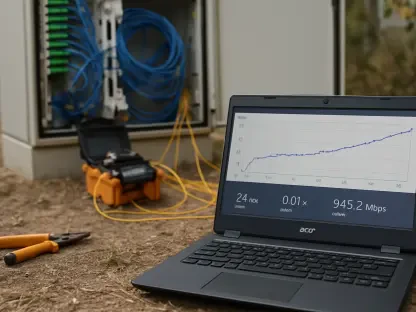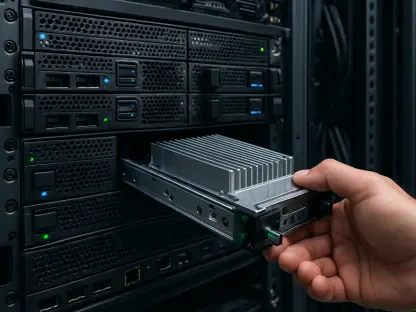In a world where edge computing is becoming the backbone of modern telecommunications, the latest release from the Open Infrastructure Foundation, now under the Linux Foundation, marks a significant milestone with StarlingX 11.0. This second major update of the year emerges as a pivotal advancement for edge cloud infrastructure, tailored specifically for the demanding environments of 5G and O-RAN deployments. Adopted by industry leaders like Verizon, Vodafone, and KDDI, this open-source platform integrates critical components such as the Linux kernel, Kubernetes, and OpenStack to deliver robust solutions. With a sharp focus on overcoming persistent challenges, this update prioritizes enhanced security for vulnerable edge locations and tackles the pressing issue of IPv4 address scarcity, all while improving operational efficiency. As edge networks expand at an unprecedented pace, StarlingX 11.0 positions itself as a cornerstone for operators navigating the complexities of large-scale implementations, promising both immediate impact and long-term adaptability.
The rapid evolution of edge computing, driven by the rollout of 5G technologies, underscores the urgency for platforms that can handle both scale and security. StarlingX 11.0 addresses these dual imperatives head-on, offering tools that protect data in remote, often unsecured locations while optimizing resources for sprawling deployments. Beyond mere functionality, the update reflects a deep understanding of the operational hurdles faced by telecom giants managing thousands of distributed sites. From safeguarding sensitive communications to ensuring seamless system updates, this release is crafted to meet real-world needs. It also aligns with broader industry shifts toward cloud-native principles, making it a forward-thinking solution for today’s challenges and tomorrow’s demands. As edge environments continue to redefine connectivity, StarlingX 11.0 stands out as a practical yet innovative response, setting a new benchmark for what edge infrastructure can achieve.
Reinforcing Edge Security
Locking Down Data at the Edge
Edge computing sites, often situated in remote and physically unsecured locations, face unique vulnerabilities that demand stringent protective measures. StarlingX 11.0 introduces a powerful solution with IPsec pod-to-pod encryption for inter-host communications, operating in tunnel mode to secure traffic across the cluster host network. This feature allows operators to apply per-service policy controls, encrypting only the data that requires protection while bypassing unnecessary overhead on interfaces like SR-IOV. Such targeted encryption ensures performance isn’t compromised, a critical factor in high-demand edge setups. This advancement directly addresses the heightened risks in regions where security testing often assumes physical access to equipment, guaranteeing that even if unauthorized entry occurs, the data remains shielded from prying eyes. It’s a proactive step toward mitigating threats in environments where traditional safeguards simply aren’t feasible.
Beyond the technical implementation, the focus on encryption highlights a growing industry concern over edge vulnerabilities. Many operators, particularly in Europe, face scenarios where third-party testers can access unused switch ports or servers at remote sites, posing significant risks to network integrity. StarlingX 11.0 counters this with a robust framework that assumes breaches could happen and prepares accordingly. The ability to selectively secure specific application traffic rather than blanket encryption demonstrates a nuanced approach, balancing security needs with operational efficiency. This feature not only protects against external threats but also builds trust among operators who must comply with stringent regulatory standards. By prioritizing data protection in such a comprehensive manner, the platform sets a high standard for safeguarding edge deployments, ensuring that sensitive information remains confidential regardless of location.
Strengthening Access with Defined Roles
Another critical layer of defense in StarlingX 11.0 comes through the introduction of new access control roles, namely “configurator” and “operator,” alongside the established admin role. These roles provide a granular framework for managing permissions, ensuring that only authorized personnel can perform specific functions in environments where physical security cannot be guaranteed. This structured approach minimizes the risk of unauthorized access, a persistent concern at the edge where equipment may be exposed to tampering. By integrating these roles with existing security features like the Harbor container registry, the platform creates a multi-tiered defense strategy. Such measures are essential for operators managing distributed networks, where the potential for insider threats or external breaches looms large, making controlled access a non-negotiable priority.
The significance of these access controls extends beyond mere restriction, reflecting a broader need for tailored security policies in edge computing. With diverse teams often operating across multiple sites, the ability to assign specific roles ensures accountability and reduces the likelihood of errors or malicious actions. StarlingX 11.0’s emphasis on role-based access also aligns with compliance requirements that demand clear separation of duties, particularly in regulated industries like telecommunications. This update empowers operators to customize security settings to match their unique operational contexts, whether dealing with a small cluster or a vast network of subclouds. By addressing both external vulnerabilities and internal risks, the platform offers a comprehensive solution that fortifies edge environments against a spectrum of threats, reinforcing confidence in system integrity.
Enhancing Scalability with Network Optimization
Addressing IPv4 Limitations
One of the most pressing challenges for operators managing massive edge deployments is the scarcity of IPv4 addresses, a bottleneck that can hinder scalability. StarlingX 11.0 tackles this issue with platform network address optimization, reducing the requirement to a single IP address per subcloud, a significant drop from the multiple addresses previously needed for operations, administration, and Kubernetes interfaces. By utilizing a shared subnet, this feature allows numerous subclouds to operate within the same address range, stretching limited resources further. For setups involving up to 5,000 subclouds in a single data center, even minor reductions per subcloud translate into substantial savings, easing the strain on IPv4-dependent infrastructures. This optimization proves invaluable for telecom operators still reliant on older systems, ensuring they can expand without being constrained by address exhaustion.
The impact of this feature goes beyond immediate resource savings, offering a lifeline to operators grappling with the practical realities of large-scale edge networks. Many organizations face delays in transitioning to newer protocols due to legacy equipment or cost considerations, making IPv4 optimization a critical stopgap. StarlingX 11.0’s approach demonstrates an acute awareness of these operational constraints, providing a solution that maximizes existing infrastructure while minimizing disruption. This efficiency also reduces the complexity of network management, allowing teams to focus on deployment rather than address allocation. As edge computing continues to scale with the proliferation of 5G, such innovations ensure that growth isn’t stifled by outdated limitations, paving the way for seamless expansion across diverse environments.
Supporting Transition with Dual-Stack Flexibility
While addressing current IPv4 challenges, StarlingX 11.0 also keeps an eye on the future by enhancing dual-stack IPv4/IPv6 support, building on capabilities introduced in earlier versions. This feature ensures operators can manage both legacy and modern systems within the same framework, offering a smooth transition path as the industry shifts toward IPv6 adoption. Such flexibility is crucial for telecom providers operating in mixed environments, where some components remain tied to older protocols while others embrace newer standards. By accommodating both, the platform prevents operators from being locked into a single approach, allowing gradual migration without sacrificing compatibility or performance. This forward-thinking design caters to diverse operational needs, ensuring edge networks remain agile amid evolving technological landscapes.
Dual-stack support also reflects a pragmatic balance between immediate scalability and long-term strategy, a necessity for operators planning expansions over the coming years. With the ability to handle both IPv4 and IPv6, StarlingX 11.0 mitigates the risk of obsolescence, providing a bridge for organizations at different stages of infrastructure modernization. This adaptability is particularly beneficial in large deployments where subclouds may operate under varying network conditions, requiring a unified yet versatile solution. The platform’s commitment to supporting this transition underscores its role as a partner in growth, enabling operators to scale confidently while preparing for industry-wide shifts. By blending current necessities with future-readiness, this feature ensures edge computing environments remain robust and responsive, no matter the underlying protocol.
Streamlining Edge Operations
Simplifying Updates with Unified Tools
Operational efficiency takes a front seat in StarlingX 11.0 with significant upgrades to the Unified Software Management (USM) framework, a toolset designed to streamline system updates and upgrades. Offering a single interface and a cohesive set of commands, USM simplifies the process of maintaining distributed edge systems, a task that can otherwise be daunting given the scale and complexity involved. This release enhances the framework with additional features aimed at improving ease of use, ensuring operators can keep pace with the frequent updates demanded by cloud-native environments. For telecom providers managing vast networks, this unified approach reduces administrative overhead, allowing focus on core operations rather than wrestling with disparate tools. It’s a clear nod to the practical needs of those on the front lines of edge computing.
The emphasis on usability through USM also addresses the dynamic nature of modern edge deployments, where staying current with software versions is essential for performance and security. StarlingX 11.0’s refinements to this framework minimize the learning curve for operators, ensuring that even complex updates can be executed with minimal friction. This is particularly vital in 5G and O-RAN contexts, where downtime or errors during updates can have cascading effects on service delivery. By providing a streamlined interface, the platform empowers teams to maintain system integrity without requiring extensive retraining or specialized expertise. Such focus on operational simplicity not only boosts efficiency but also enhances reliability, making StarlingX a trusted choice for managing the intricate demands of edge infrastructure.
Mitigating Risks with Rollback Capabilities
System updates, while necessary, often carry the risk of unintended disruptions, a concern StarlingX 11.0 addresses with extended rollback support. This feature provides operators with more options to revert configurations if an update goes awry, significantly reducing the potential for prolonged downtime or operational hiccups. In edge environments where reliability is paramount, having such a safety net offers peace of mind, encouraging teams to implement updates without the fear of irreversible errors. This capability is especially critical for large-scale deployments, where a single misstep can impact thousands of subclouds or end users. By prioritizing risk mitigation, the platform ensures that maintaining cutting-edge systems doesn’t come at the cost of stability.
The rollback enhancements also underscore a broader commitment to operational resilience, a key factor for operators navigating the unpredictable nature of edge computing. Unlike centralized data centers, edge sites often operate under variable conditions, making the ability to quickly recover from issues a game-changer. StarlingX 11.0’s expanded options for configuration reversal cater to this reality, offering tailored solutions that match the unique challenges of distributed networks. This focus on minimizing disruption aligns with the needs of telecom providers who must balance innovation with uninterrupted service, particularly in high-stakes 5G rollouts. By embedding such protective measures, the platform not only boosts confidence in system updates but also reinforces its role as a dependable foundation for edge operations.
Reflecting on Industry Impact
Looking back, StarlingX 11.0 proved to be a transformative update for edge computing, particularly within the telecommunications sector. Its robust IPsec encryption and refined access controls tackled the inherent vulnerabilities of remote edge sites, offering operators a fortified shield against evolving threats. The optimization of IPv4 address usage delivered much-needed relief for massive deployments, while dual-stack support laid a foundation for future transitions. Additionally, enhancements to software management and rollback options streamlined operations, ensuring reliability amid frequent updates. For industry leaders like Verizon and Vodafone, these advancements provided practical tools to address both immediate constraints and long-term goals. As the platform responded to critical trends in security, scalability, and cloud-native efficiency, it cemented its position as a vital asset. Moving forward, operators were encouraged to leverage these features for enhanced network resilience, explore gradual IPv6 adoption, and prioritize security audits to stay ahead of risks, ensuring sustained growth in an ever-expanding edge landscape.









